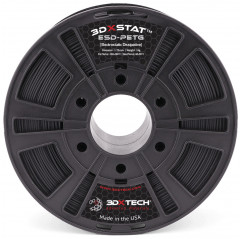Package Contains: 1 x 3DXSTAT ESD-PETG - Black / 1.75mm / 1kg - 3DXTech
3DXSTAT? ESD-PETG is an advanced ESD-Safe compound designed for use in critical applications that require protection against electrostatic discharge (ESD). Manufactured using state-of-the-art multi-walled carbon nanotube technology, cutting-edge compounding technology and precision extrusion processes. Target surface resistance: 10^7 to 10^9 Ohms. An alternative to Zortrax Z-ESD
PETG advantages include:
Superior chemical resistance compared to ABS
Amorphous structure giving it low shrinkage, nearly isotropic
Low moisture absorption, 3 times less than ABS
Very low odor emission during printing
Superior ductility compared to ABS
Wide processing range of 230-260°C
3DXSTAT? advantages include:
Constant surface resistivity
Improved impact retention and elongation
Low particulate contamination
Minimal contribution to outgassing and ionic contamination
Chemical resistance of PETG:
Unstressed tensile bars printed in PETG exhibit good resistance to dilute aqueous solutions of mineral acids, bases, salts and soaps and to aliphatic hydrocarbons, alcohols and a variety of oils. Halogenated hydrocarbons, short chain ketones and aromatic hydrocarbons dissolve or swell the plastic.
Typical ESD-PETG applications include:
Semi-con: HDD components, wafer handling, masks, enclosures and connectors
Industrial: transportation, measurement and sensing applications
Target conductivity for 3DXSTAT ESD-PETG:
Surface resistivity from 10^7 to 10^9 ohms on 3DP sample using concentric ring test method.
Note: Internal studies have indicated that increasing extruder temperatures can achieve higher levels of conductivity. Similarly, lower extruder temperatures have resulted in lower levels of conductivity. Each printer is configured differently as well as part geometry varies. Therefore, expect some testing time to understand how this filament works in your specific printer/application. However, do not exceed 270°C to reduce the risk of polymer degradation.
Surface conductivity as a function of extruder temperature:
The surface resistance of the ESD-proof printed part varies with the temperature of the printer extruder. For example, if the test indicates that the part is too insulating, increasing the extruder temperature will result in better conductivity. Therefore, surface resistance can be "made up" by adjusting the extruder temperature up or down depending on the reading you receive from your side.
Filament specifications:
Diameter: 1.75 mm (+/- 0.05 mm)
Recommended print settings:
Extruder: 230-260°C
Platen temperature: 60-90°C
Platen preparation: adhesive or poly tape recommended
Heated chamber: not required
Media: Water soluble AquaTek X1 USM works great for complex parts.
Drying instructions: 65°C for 4 hours.









![ESD-FLEX [TPU] 3D FILAMENT - Black / 1.75mm / 750g - 3DXTech ESD-Safe 19210060 3DXTech](www.dhm-online.com/4900151-home_default/esd-flex-tpu-3d-filament-black-175mm-750g-3dxtech.jpg)


